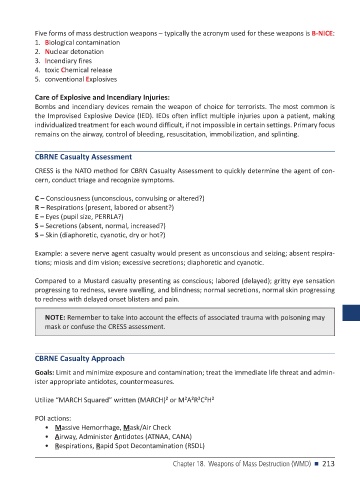Page 215 - PJ MED OPS Handbook 8th Ed
P. 215
Five forms of mass destruction weapons – typically the acronym used for these weapons is B-NICE:
1. Biological contamination
2. Nuclear detonation
3. Incendiary fires
4. toxic Chemical release
5. conventional Explosives
Care of Explosive and Incendiary Injuries:
Bombs and incendiary devices remain the weapon of choice for terrorists. The most common is
the Improvised Explosive Device (IED). IEDs often inflict multiple injuries upon a patient, making
individualized treatment for each wound difficult, if not impossible in certain settings. Primary focus
remains on the airway, control of bleeding, resuscitation, immobilization, and splinting.
CBRNE Casualty Assessment
CRESS is the NATO method for CBRN Casualty Assessment to quickly determine the agent of con-
cern, conduct triage and recognize symptoms.
C – Consciousness (unconscious, convulsing or altered?)
R – Respirations (present, labored or absent?)
E – Eyes (pupil size, PERRLA?)
S – Secretions (absent, normal, increased?)
S – Skin (diaphoretic, cyanotic, dry or hot?)
Example: a severe nerve agent casualty would present as unconscious and seizing; absent respira-
tions; miosis and dim vision; excessive secretions; diaphoretic and cyanotic.
Compared to a Mustard casualty presenting as conscious; labored (delayed); gritty eye sensation
progressing to redness, severe swelling, and blindness; normal secretions, normal skin progressing
to redness with delayed onset blisters and pain.
NOTE: Remember to take into account the effects of associated trauma with poisoning may
mask or confuse the CRESS assessment.
CBRNE Casualty Approach
Goals: Limit and minimize exposure and contamination; treat the immediate life threat and admin-
ister appropriate antidotes, countermeasures.
Utilize “MARCH Squared” written (MARCH)² or M²A²R²C²H²
POI actions:
• Massive Hemorrhage, Mask/Air Check
• Airway, Administer Antidotes (ATNAA, CANA)
• Respirations, Rapid Spot Decontamination (RSDL)
Chapter 18. Weapons of Mass Destruction (WMD) n 213

